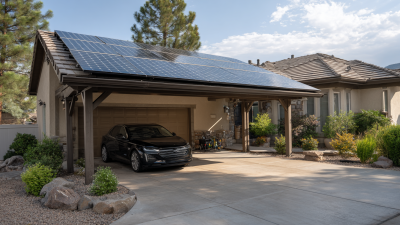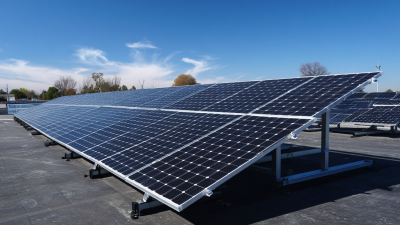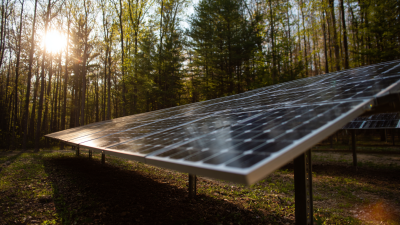Maximizing Energy Efficiency: A Comprehensive Guide to Solar System Installation Benefits
In the pursuit of sustainable energy solutions, the importance of solar system installation cannot be overstated. With the rising costs of traditional energy sources and growing environmental concerns, many homeowners and businesses are considering solar power as a viable alternative. According to renowned solar energy expert Dr. Emily Santos, “Investing in solar system installation not only reduces your carbon footprint but also significantly lowers your energy bills in the long run.” This statement underscores the dual benefit of adopting solar technology—contributing to environmental preservation while achieving economic savings.

Moreover, the advantages of solar system installation extend beyond mere cost efficiency. As governments around the world implement policies encouraging renewable energy, individuals who invest in solar technology stand to gain from various incentives, tax credits, and rebates. This comprehensive guide aims to delve into the myriad benefits of solar system installation, offering insights that can help prospective solar users make informed decisions. By understanding the installation process, financial opportunities, and long-term benefits, readers can maximize their energy efficiency and contribute to a more sustainable future.
Understanding Solar Energy: Fundamentals and Advantages
Understanding solar energy is crucial as it offers numerous advantages for both individual households and the larger environment. Solar power is one of the most reliable renewable energy sources, providing sustainable energy solutions while significantly reducing carbon footprints. With advancements in technology, solar systems have become more efficient, maximizing energy capture and utilization. One exciting development is floating photovoltaic systems, which utilize water surfaces for solar installations, minimizing land use and enhancing energy output.
**Tips**: When considering solar panel installation, assess your roof's orientation and shading to ensure optimal sunlight exposure. Additionally, exploring local incentives for solar energy can provide financial benefits that make installation more accessible.
The transition to solar energy is further boosted by the increased demand for clean energy across various sectors, including the burgeoning artificial intelligence industry. This push emphasizes the need for sustainable sources to support new technologies. The economic case for solar energy remains compelling amidst the fluctuating energy landscape, making it a sound investment for the future.
**Tips**: Regular maintenance and monitoring of your solar system can enhance its longevity and performance. Don't forget to consult with energy specialists to tailor a solution that best fits your energy needs.
Maximizing Energy Efficiency: A Comprehensive Overview of Solar System Installation Benefits
Assessing Your Energy Needs for Optimal Solar System Design
Assessing your energy needs is a crucial step in designing an optimal solar system. Understanding your household's energy consumption patterns will help determine the size and capacity of the solar system required to meet your needs effectively. Factors such as the number of occupants, daily usage of electricity, and the types of appliances in your home play significant roles in this assessment. By analyzing past utility bills and identifying peak usage times, you can make informed decisions that ultimately enhance energy efficiency.
- Track your monthly energy consumption over a year to identify patterns and peak usage periods.
- Consider future energy needs, such as potential electric vehicle charging or home expansions, when sizing your solar system.
- Consult with solar professionals who can provide detailed energy audits and tailored recommendations based on your specific situation.
With the solar rooftop mounting market projected to grow to $38.34 billion by 2032, the increasing interest in all-weather low-carbon energy solutions is shaping the future of renewable energy. By integrating intermittent renewable systems with existing energy sources, homeowners can significantly reduce their reliance on fossil fuels, contributing to a sustainable energy landscape. Ensuring that your solar system is designed around your unique energy needs will maximize efficiency and energy savings for years to come.
Types of Solar Systems: Choosing the Right Fit for Your Home
When considering solar system installation for your home, it's essential to understand the various types available to ensure you choose the right fit. The two primary solar systems are grid-tied and off-grid systems. Grid-tied systems are connected to the local utility grid, allowing homeowners to draw from the grid when solar production is low and sell excess energy back when production exceeds consumption. This is an excellent option for those looking to maximize their energy savings without the upfront costs of battery storage.
On the other hand, off-grid solar systems provide complete independence from the utility grid. These systems are ideal for remote locations or homeowners seeking to eliminate reliance on traditional power sources. However, they require battery storage to ensure a consistent energy supply during non-sunny days, which can raise the initial investment.
Tips: Before installation, evaluate your energy needs and location. If you live in an area with abundant sunshine, an off-grid option might be less necessary. Additionally, consider the long-term financial benefits of each system against your current energy costs. Consulting with a solar energy professional can also help identify the best layout and system size for your unique circumstances.
Installation Process: Steps to Seamless Solar System Integration
Installing a solar system can seem daunting, but understanding the installation process is key to a successful and seamless integration. The typical solar installation process includes site assessment, system design, permitting, installation, and inspection. According to the National Renewable Energy Laboratory (NREL), a well-planned installation can reduce energy costs by up to 60% over 20 years. Proper planning ensures optimal system performance and longevity, which is why engaging with experienced professionals is critical.
Tip: Always start with a thorough energy audit of your home to determine your energy needs. This not only helps in designing a tailor-made solar system but also aids in securing the necessary permits more easily.
Once the design is approved and permits are obtained, the actual installation involves mounting the solar panels, wiring, and connecting to the grid. Industry data shows that solar panel efficiency has improved significantly, with the average efficiency of panels reaching around 20% as of 2023. This has made integrating solar into both residential and commercial properties more effective and profitable.
Tip: Consider the orientation and shading of your roof during installation to maximize energy capture throughout the year. An inverter's performance is also crucial, as it converts the DC electricity generated by the panels into usable AC electricity, potentially affecting overall system efficiency.
Financial Incentives: Maximizing Savings through Solar Installations
The financial incentives surrounding solar installations play a crucial role in maximizing savings for homeowners and businesses alike. Governments and local authorities often offer an array of tax credits, rebates, and grants designed to encourage the adoption of renewable energy. These incentives can significantly reduce the initial investment required for solar panel installation, making the technology more accessible and appealing. For example, the federal Investment Tax Credit (ITC) allows homeowners to deduct a percentage of the installation costs from their federal taxes, translating into substantial savings over time.
Additionally, many states and municipalities have their own incentive programs, which can include property tax exemptions or feed-in tariffs that pay solar energy producers for the electricity they generate. By taking advantage of these financial benefits, individuals can not only lower their utility bills but also increase their return on investment in solar technology. With rising electricity costs, investing in solar systems becomes increasingly lucrative, turning a sustainable choice into a financially sound one. As awareness of these incentives grows, more people are likely to consider solar energy investments as a practical solution for reducing their overall energy expenditure.
Related Posts
-

Why Solar System Installation is a Smart Move for Your Home
-

Top Industry Standards and Key Reasons to Choose the Best Solar Energy Panels for Global Buyers
-

10 Essential Tips for Sourcing Solar Panels Effectively in 2024
-

What is Solar System Installation? Unlocking the Key Components and Benefits for Your Home
-

How to Seamlessly Integrate Solar Energy Installation into Your Home
-

Exploring the Future of Solar Energy Installation and Its Impact on Sustainable Living